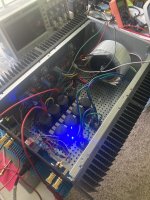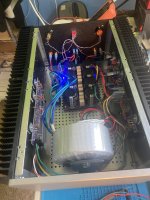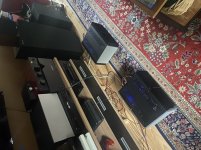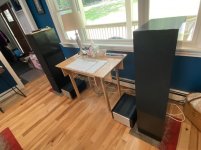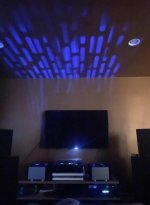This morning I've been biasing up to the .370 range. I'm doing Aleph 60 in the new monoblock chassis, whose sinks are 165mm (4U) tall and 400mm deep, with the main board on one side and the expansion on the other. After two hours of idling with the covers on, sinks are not quite at 50C.Toad, how are your mosfet case temperatures at that setting? Getting close to 55° or staying pretty low?
Did you finalize your donut location? Share some pix and listening impressions when you’re done!
My bias measurement results are interesting, with a variability of 2-3% comparing the pairs. Amp and sinks well over an hour warmed up and biased with the cover on, I'd turn it off, hook up three voltmeters, turn it on, cover, wait ten, then check readings, move to next set of three, repeat. Source resistors 1R :
edited to note: the HTML Table mechanism doesn't work, so here's ascii:
Current Source | Paired Output, mV
R36 | R40 : 357 | 366
R37 | R41 : 370 | 387
R39 | R43 : 363 | 352
Exp AC | Exp AO : 375 | 350
Exp CC | Exp CO : 384 | 388
Exp DC | Exp DO : 370 | 355
What do you make of that? Good, bad, dandy?
Next up will be setting the AC gain and DC offset. After that, well, I've got to assemble and wire up channel #2. Boards are built and power supply is ready, but it is a few hours of work yet.
Last edited:
Those measurements look good.
Adding up to 2.2A for Current Source and Outputs, and all of the MOSFETs are taking a similar share of the load (~12-13W each assuming 34V rails).
What's happening with extra binding posts?
Did you implement a Balanced / Single Ended toggle switch?
I'm curious to hear your report on sonic impressions.
Any hum report after optimizing the rotation of the donut? It looks like you ran umbillical on the donut end. If you're getting hum, try the other end. If not, put a lid on it and enjoy!
Did you see the new AC Gain doc in Post #1? I hope that is helpful.
Adding up to 2.2A for Current Source and Outputs, and all of the MOSFETs are taking a similar share of the load (~12-13W each assuming 34V rails).
What's happening with extra binding posts?
Did you implement a Balanced / Single Ended toggle switch?
I'm curious to hear your report on sonic impressions.
Any hum report after optimizing the rotation of the donut? It looks like you ran umbillical on the donut end. If you're getting hum, try the other end. If not, put a lid on it and enjoy!
Did you see the new AC Gain doc in Post #1? I hope that is helpful.
Dumb question:
I've set this up for bi-wiring with two pairs of binding posts on each monobloc. Any reason I couldn't / shouldn't send the signal to the second pair of binding posts from the expansion board's OP? It's super conveniently located next to the binding post. Schematically/logically it should be the same as if I had used the middle OP connection point of the main board.
See my amazing ppt artwork below:

I've set this up for bi-wiring with two pairs of binding posts on each monobloc. Any reason I couldn't / shouldn't send the signal to the second pair of binding posts from the expansion board's OP? It's super conveniently located next to the binding post. Schematically/logically it should be the same as if I had used the middle OP connection point of the main board.
See my amazing ppt artwork below:
OP from between the boards isn't the same as speaker +. So you can't do that. And the chassis ground through screw on the PDF artwork is on the other side of the hum break CL-60. So that's no good, either.
Ideal wiring is to "Y" from the same points on the board with twisted pairs to both speaker binding post pairs.
You could also daisy chain from PCB to binding post to next binding post. Twist the wires.
Ideal wiring is to "Y" from the same points on the board with twisted pairs to both speaker binding post pairs.
You could also daisy chain from PCB to binding post to next binding post. Twist the wires.
Thumbs up!Those measurements look good.
Adding up to 2.2A for Current Source and Outputs, and all of the MOSFETs are taking a similar share of the load (~12-13W each assuming 34V rails).
I did! Basically for the single ended, I shorted the ground and negative posts of the toggle switch for the single ended side. I don't (yet) have a pre-amp with XLR outs, but I do have a Henry Matchbox I've used on a Crestron amp to bridge its channels.What's happening with extra binding posts?
Did you implement a Balanced / Single Ended toggle switch?
Well, so am I. Have to assemble #2I'm curious to hear your report on sonic impressions.
In my lab/home office/master bedroom, running of an iso transformer into a variac, can put my ear up to the tweeter of the cheapo in-wall speaker and hear the slightest of hisses. That's par for the course with my other builds and I expect that to go away when I take it downstairs, just as it has with other amps I've built.Any hum report after optimizing the rotation of the donut? It looks like you ran umbillical on the donut end. If you're getting hum, try the other end. If not, put a lid on it and enjoy!
I did and I even printed it out and filled it in. And my voltmeter was on AC! So now I'm biased, gained, and have the DC offset floating under 10mv.Did you see the new AC Gain doc in Post #1? I hope that is helpful.
Glad I asked,OP from between the boards isn't the same as speaker +. So you can't do that. And the chassis ground through screw on the PDF artwork is on the other side of the hum break CL-60. So that's no good, either.
Roger, WILCO.Ideal wiring is to "Y" from the same points on the board with twisted pairs to both speaker binding post pairs.
You could also daisy chain from PCB to binding post to next binding post. Twist the wires.
Hey Randy
Got my Aleph 60 bundle in the mail on the way out the door for a memorial day getaway with kidos
Looking over documentation…WOW!…gonna need some help with this one for sure!
Good to see some of you more advanced guys documenting your builds…keep the info coming!
Got my Aleph 60 bundle in the mail on the way out the door for a memorial day getaway with kidos
Looking over documentation…WOW!…gonna need some help with this one for sure!
Good to see some of you more advanced guys documenting your builds…keep the info coming!
Seeing as how the Quasimoto test jig pcb is no longer available, how do I come up with a number for Snubber R metal film resistor value? I'm using 27k uf 25v C1-8 caps.
This is for F5 dual rail decoupled PS
This is for F5 dual rail decoupled PS
This was helpful for me: https://www.diyaudio.com/community/threads/quasimodo-results-only.313202/page-6#post-6941670
Which donut? If you’re using Antek, use a 20RSeeing as how the Quasimoto test jig pcb is no longer available, how do I come up with a number for Snubber R metal film resistor value? I'm using 27k uf 25v C1-8 caps.
This is for F5 dual rail decoupled PS
One word review: Authoritative.I'm curious to hear your report on sonic impressions.
Just completely in control of the foundation. Kick drums, snare drums, stand up bass, electric bass, synthesizers... slam.
They were a little piercing at first; the sweetness of acoustic guitars, of space in the room, of air just wasn't there. Until about 4 hours of burn in. Then the roses bloomed and everything had space and sweetness to go with the authority.
It's funny building these very different class A amps. Each is astonishing yet different. The F6, for example, sings to me. But the F4 and the Aleph 60 are the first two amps I've heard where instead of closing your eyes to focus your attention on listening, just keep them open. Everything is presented for you.
Thanks for making these boards, Randy. I remember reading about the original Aleph in Stereophile way back in the early 90s as a young twenty-something with two pennies to stack together, dreaming. And now I've made a pair of monoblocks! How cool is that?
Attachments
One word review: Authoritative.
Just completely in control of the foundation. Kick drums, snare drums, stand up bass, electric bass, synthesizers... slam.
They were a little piercing at first; the sweetness of acoustic guitars, of space in the room, of air just wasn't there. Until about 4 hours of burn in. Then the roses bloomed and everything had space and sweetness to go with the authority.
It's funny building these very different class A amps. Each is astonishing yet different. The F6, for example, sings to me. But the F4 and the Aleph 60 are the first two amps I've heard where instead of closing your eyes to focus your attention on listening, just keep them open. Everything is presented for you.
Thanks for making these boards, Randy. I remember reading about the original Aleph in Stereophile way back in the early 90s as a young twenty-something with two pennies to stack together, dreaming. And now I've made a pair of monoblocks! How cool is that?
Since you are writing about the sound, not the build...
What kind of speakers are those?
My mono A5s, born as Rawson amps and rebuilt nicely not so long ago... which I believe were the impetus for his building his 60s... sound beautiful indeed,
I got mine driving a pair of Maggie 1.7's and as my wife said, it sounds like music, not a stereo. We no longer close our eyes, we just listen in absolute wonderment. I run a CJ PV9 fully upgraded to SE with an LP12/Ittok/Lingo/Grado and it sounds really, REALLY good. The guy who rebuilt my table came by to deliver it, before the A5 rebuild, and he was astonished at how good the system sounded.. and he's a guy with a long pedigree in High End audio manufacturing ( he did tell me to try the Purify amps, but noted the A5s sound extremely sweet).
But I have a problem... not enough power for the Maggies. The bass is not "authoritative" as you pointed out. Acoustic guitars.... bluegrass harmonies... Ay! That's the forte. The sound of a saxophone...
I tried a newly rebuilt Marantz 2325 and it did sound louder but I could see the lights on its front panel dim during transients... so I took it out of that circuit... besides, it sounded electronic. The A5 only go to 8. I'm not asking for 11, mind you.. but I would like the hear what the speakers truly can do and for that I will need the A2s or someday an ARC VT200. The ARC D70 MkII's are in the same place as the A5, with a looser low end, somewhat deeper soundstage, equal midrange and treble.... but with the additional neurosis of tubes.
( I do bias my own D70... with a 40 year old Radio Shack multi meter... of course. Fully analog, what else? ).
Try Carole King's You Got A Friend ( I got the original pressing ) or Traffic's John Barleycorn. Both are in the sweet spot for the A5/Maggie combination. Surprisingly, the little F5 drives Ozzie quite well in the L810s, but those are efficient speakers. I realize that Ozzie and sounding well may be hard to understand... so how about Zappa Live At The Roxy?
The F5 and L810 combo has an immediacy lacking in the A5/Maggies, while the latter has a stage presence that needs to be experienced. I guess you could expect that a dipole will make it sound like that, but the 810s are 40 year old speakers and it takes the F5 to make them sound really good, even if with a softer top end (soft dome tweeter).
So now I'm waiting for my A2s. And hopefully i'll raise the money for the F5 V3 Turbos later this year. I do wonder what the F5 Turbos will do, I think I know what the A2s will do: an A5 with 6db more dynamics, meaning more control on the crescendos. I have a DIY F5 that You Know Who applied his magic too and it sounds great, but at 25w it's hooked up to my vintage ADS L810s. There they sound fantastic. Especially when I pair them with the B1K. ;-)
As you well pointed out though. Once you get used to this sound, you can't go back, even as I have an Audio Research D70 MkII as well...
I must say I can't wait for the 200 watt A2s. Those should drive the Maggies extremely well. You just gotta wait for the Red Moon Rising.
Oh, congratulations on your building your amps. I'm jealous but I just don't have the time nor the bench to do so. I sold my scope years ago and only do occasional, and messy, soldering. But it's great to find people who do what I just read about. And since I read schematics, I do have a good time watching you all do it. OTOH, there's a brand new network rack in my data closet with newly upgraded NAS servers.... yeah, yeah.. digital stuff.
I wonder... I've seen some used Harbeth M30.1's on sale... would those sound good on the F5 and F5 Turbos? I'm sure the A5s will make them sing.
But for the OP, I'm holding on to the doughnuts. We drove by Randy's Doughnuts in Inglewood on Memorial Day but it had a huge line outside so we didn't stop and went to get our food down in Torrance. I wonder if the OP likes pork tonkatsu.
Last edited:
See, now, we're here to talk about building gear, not gear. 😗What kind of speakers are those?
But, since you asked... The towers are a pair of Snell B Minors, which are the reason I built the Alephs. Yup, the Alephs manhandle their 12" acoustic-suspension woofers. But those are in the pool table room, so not really an ideal listening environment.
Where the Alephs ended up are in the main living room rig. The speakers I'm using are an astonishing value and little-known gem, HSU HB1mk2 bookshelves. An efficient controlled-directivity horn and 6" woofer two-way that continue to amaze. Smooth, never shrill, image like mad, with timbre and dynamics that reveal more about the source equipment. Get your own pair shiny new for $400. Toss in the HSU VTF2 mk5 sub (which is what HSU is known for), and that's why the B Minors are in the pool room. The black "speaker stands" are in fact some old Snell E-2s.
Listening to Cowboy Junkies' Trinity Session, Mining for Gold last night, the church she's singing acapella in doesn't just reverb her voice, but you hear it echo, bounce. Twice. Talk about resolving space. I just threw up my arms, "Well, there it is." The Alephs continue to bloom and break in.
Brilliant description....thanks ...really made me smile and almost.... Almost......took me there.
- Home
- Amplifiers
- Pass Labs
- Classic Aleph Amplifier for Modern UMS Chassis Builder's Thread

